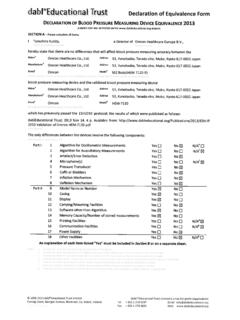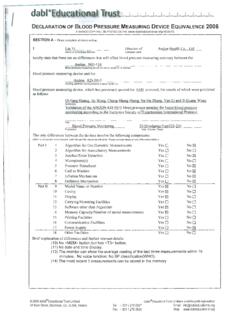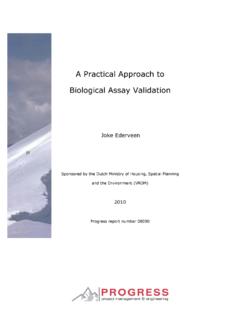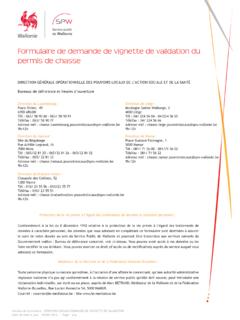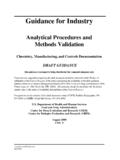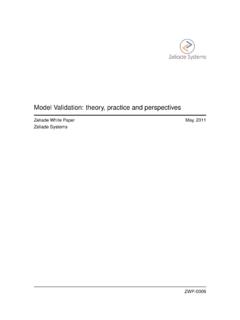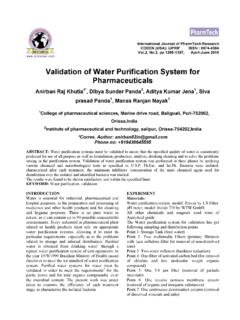Transcription of European Society of Hypertension International Protocol ...
1 Special articles from the ESH working group on blood pressure monitoring 23 European Society of Hypertension International Protocolrevision 2010 for the validation of blood pressure measuringdevices in adultsEoin O Briena, Neil Atkinsb, George Stergiouc, Nikos Karpettasc,Gianfranco Paratid, Roland Asmare, Yutaka Imaif, Jiguang Wangg,Thomas Mengdenhand Andrew Shennani; on behalf of the Working Groupon Blood Pressure Monitoring of the European Society of HypertensionBlood Pressure Monitoring2010,15:23 38 Keywords: blood pressure, blood pressure measurement, device validation , European Society of Hypertension , International Protocol , protocolaThe Conway Institute of Biomolecular and Biomedical Research, UniversityCollege Dublin, Ireland,bdabl Ltd.
2 , Blackrock Co., Dublin, Ireland,cHypertensionCenter, Third University Department of Medicine, Sotiria Hospital, Athens,Greece,dIstituto Scientifico Ospedale San Luca, IRCCS, Instituto AuxologicoItaliano, Milan, Italy,eSocie te Franc aise d Hypertension Arte rielle, Filiale de laSocie te Franc aise de Cardiolgie, Paris, France,fThe Department of ClinicalPharmacology and Therapeutics, Tohoku University Graduate School ofPharmaceutical Science and Medicine, Sendai, Japan,gCentre forEpidemiological Studies and Clinical Trials, Ruijin Hospital, Shanghai JiaotongUniversity School of Medicine, Shanghai, China,hUniversity Clinic Bonn,Department of Internal Medicine, Bonn.
3 Germany andiGuy s and St Thomas Hospitals, London, UKCorrespondence to Professor Eoin O Brien, Blood Pressure Unit, St. Michael sHospital, Du n Laoghaire, Co. Dublin, IrelandTel: + 353 1 2803865; fax: + 353 1 2803688; e-mail: July 2009 Revised18 August 2009 Accepted18 August 2009 IntroductionMeasurement of blood pressure is the commonestmeasurement made in clinical practice, and the inter-pretation of the figure resulting from that measurementhas far-reaching implications for the individual in whomthe technique is performed. If the measurement iserroneously low, for example, the patient may be deniedthe most valuable drug treatment to prevent futurestroke and heart attack, whereas if, on the other hand, themeasurement is erroneously high, the individual may becommenced on lifelong blood pressure lowering drugsunnecessarily.
4 It is imperative, therefore, that the devicebeing used to measure blood pressure is accurate and,because blood pressure is a complex haemodynamicvariable, it is accepted that all blood pressure measuringdevices must be validated independently in the of blood pressure measuring devices beganin the 1980s with a series ofad hocvalidation protocolson devices [1]. From the 1990s onwards, device valida-tion became more structured with the publicationof standards and protocols from the Association for theAdvancement of Medical Instrumentation (AAMI) andthe British Hypertension Society (BHS) [2 7].
5 In 2002,the Working Group on Blood Pressure Monitoring of theEuropean Society of Hypertension (ESH), which iscomposed of experts in blood pressure measurement,many of whom have considerable experience in validatingblood pressure measuring devices, published theInter-national Protocol , which simplified previous protocols andwas based on evidence from a large number of valida-tion studies [8]. The International Protocol was draftedin such a way as to be applicable to the majority ofblood pressure measuring devices on the market. Thevalidation procedure was therefore confined to adultsover the age of 30 years (who constitute the majority ofsubjects with Hypertension ), and it did not makerecommendations for special groups, such as children,pregnant women and the elderly, or for special circum-stances, such as during exercise, or for abnormalpathophysiological circumstances, such as atrial fibrilla-tion, or arterial stiffness as may occur in the elderly.
6 Theprotocol did not preclude investigators and manufacturersfrom applying the International Protocol to assessmentand validation in these circumstances. For full back-ground information on this revision, it is recommendedthat investigators familiarise themselves with the originalprotocol, which can be downloaded directly , the results of validation studies were publishedin peer-reviewed journals and, every few years, state-of-the-market papers summarising device accuracy werepublished in general and specialised journals [9]. How-ever, it became apparent that many of these publicationswere not accessible to many would-be purchasers of bloodpressure measuring devices.
7 To overcome this deficiency,the Working Group of the European Society of Hyperten-sion launched in now receives visits from over 5000 organisations in100 countries in all c2010 Wolters Kluwer Health | Lippincott Williams & WilkinsDOI: the International Protocol was published in 2002,78 reported studies have been analysed and this analysisis the evidence base for the changes being incorporated inthe first revision of the International Protocol [1,10].Because of the increasing ban on the use of mercury-containing sphygmomanometers, there is a need for anequivalent standard device that does not contain following are the basic changes to the revisedprotocol:(1) Forms replace free-text results so that all data mustbe standardised.
8 (2) The age restriction is reduced from 30 to 25 years tofacilitate recruitment.(3) Phase 1 has been removed, as this is now consideredredundant.(4) As a consequence of improvements in technology,pass levels have been tightened. This is of benefit tomanufacturers who strive to produce devices of thehighest standard.(5) Controls on the distribution of observer measure-ments are introduced to ensure that the intendedrecruitmentrangesarereasonablyma intainedthroughout the full procedure.(6) Due to difficulties experienced in recruiting subjectsin high ranges, the recruitment limits have beenrelaxed under certain facilities provided by the dablEducational websiteto assist validation studies are outlined in Appendix passing the stricter criteria of this revision willbe classed as having passed ESH-IP2.
9 It will supersedethe original Protocol [8] for new studies from 1st July2010 and for publications from 1st July sphygmocorder [11,12] option described in theprevious Protocol is not included because no validatedmodel is currently Protocol validation applies only to the recordedmeasurements and does not extend to average measure-ments or any other derived requirementsGeneral requirementsEnvironment:(1) The room should be at a comfortable temperatureand there should be no noise or other influences thatmay cause disturbance, such as telephones andpagers.(2) Ambient noise should not be at a level that couldinterfere with the auscultation of blood :(1) Two standard mercury sphygmomanometers, thecomponents of which have been checked carefullybefore the study, are used as reference should be within 1 m of the observers whoshould be able to follow the menisci at eye level from40 mmHg to 180 mmHg.
10 (2) Bladders must be available so that, on each subject,there is one of sufficient length to encircle 80% 100%of the arm circumference [13].(3) Good quality nonelectronic stethoscopes with well-fitting earpieces should be device:(1) The test device bladder should be that providedaccording to the manufacturer s instructions. Ifdifferent cuff sizes are recommended by themanufacturer, the appropriate cuff/bladder shouldbe used but no other part of the apparatus should bechanged.(2) If the device detects blood pressure by auscultation,the same microphone(s) must be used throughoutthe validation test.(3) If the test device requires software, this should beloaded and tested.



